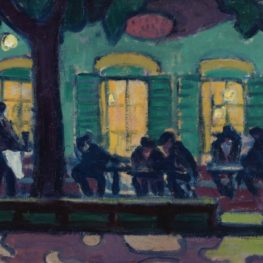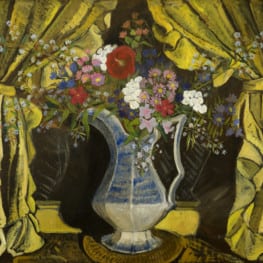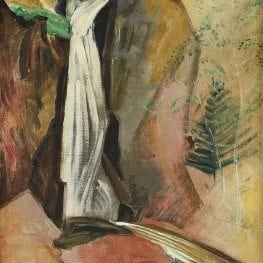Marguerite Zorach
1887-1968
Marguerite Thompson Zorach produced most of her innovative work from shortly after her first arrival in Paris in 1908 until 1920. This was a period of experimentation with style and technique, and Zorach successfully integrated color strategies then being developed in Paris into her own style. Upon her return to the United States, Thompson actively promoted Modernism with avant-garde writers and artists in New York and New England.
Zorach was born Marguerite Thompson on September 25, 1887 in Santa Rosa, California to a prominent family whose ancestry can be traced back to the early New England settlers. From her sixth year, she was filling notebooks with drawings. She had just enrolled at Stamford University in 1908 when her aunt, artist Adelaide Harris, invited her to come to Paris. En route to Europe, Zorach made a stop-over in Chicago where she witnessed her first Impressionist paintings. Her aunt introduced her to Gertrude Stein, a friend from San Francisco. Although Zorach did not frequent the Stein salon, she did meet Picasso on occasion and became a close friend of the sculptor Ossip Zadkine. Zorach was very receptive to Matisse’s work and felt an immediate affinity with the French Fauves.
For a time Zorach studied at the conservative Ecole de la Grande Chaumiere and privately with Francis Zuburtin. She and fellow artist Jessie Dismorr traveled together throughout Europe visiting museums and galleries and painting. The summer of 1910 they visited Provence, where the brilliant panorama reminded her of California. The vivid hues evidenced in her paintings there are as much a tribute to nature as to her own liberated approach to color. Her work began to be seen publicly in this period, as she exhibited at the American Women’s Art Association and at the Salon des Indépendants in 1910 and the Salon d’Automne in 1911.
Zorach and Dismorr attended the progressive art school La Palette in Paris in March 1911. Zorach studied with Scottish colourist John D. Fergusson, who managed La Palette, and with the more traditional Jacques Emile Blanche. Fergusson, who was one of the founders of the London periodical Rhythm, published many of Zorach’s drawings. It was at La Palette that she met her future husband William Zorach, a lithographer from Cleveland.
After Zorach left La Palette in the fall of 1911, she and her aunt departed on a voyage through the Middle East. The landscapes from her journey are rich with saturated color and simplified, abstracted forms.
Zorach arrived in San Francisco in April of 1912 and spent the summer camping in the Sierra Mountains. Aware of the difficulties of climbing with paint box and canvas, she made many pen and ink drawings, yet strong paintings also resulted from the summer. The Royar Galleries in Los Angeles sponsored her first one-person show in 1912, which attracted a large crowd. The show was remounted at the Parlor Club in Fresno, California.
Marguerite and William Zorach were married on December 24, 1912 in New York City. Urban life depressed Marguerite, and as a compromise they agreed to spend the summers surrounded by nature. Most of her oils stem from those summer retreats.
Zorach displayed a new angularity and flatness of form derived from Cubism to which she was exposed at the Armory Show of 1913 in which both she and her husband exhibited. She had a one-person show at the Daniel Gallery in New York in 1915. She was also selected out of seventeen artists to exhibit at the Forum exhibition at the Anderson Galleries in 1916, an attempt to bring the best modern paintings to the American public. Her good friend Abraham Walkowitz introduced her to Hamilton Easter Field, a critic and patron of the arts and founder of Arts magazine. Field lent her and her husband his farm in Randolph, New Hampshire for the summer of 1915 where they painted zealously.
The summer of 1916 was spent in Provincetown, Massachusetts with artist friends Marsden Hartley, Charles Demuth and Walkowitz. The Provincetown canvases reflect an involvement with Cubism. Both Zorachs participated in the exhibition of the Society of Independent Artists in 1917 at the Grand Central Palace.
From 1920 onwards Marguerite devoted a substantial amount of her energies to designing and making embroideries, though she never completely abandoned painting. Her embroideries drew high praise from art critics and collectors alike. Though she had shown her tapestries at Charles Daniel’s Gallery in 1918, it was a joint exhibition with her husband. She had her first one-person show of her needlework, “Embroidered Tapestries by Marguerite Zorach” at Montross Gallery in New York in 1923. Although Marguerite focused more on her tapestries and embroideries in the 1920s and 1930s she returned to oil paintings in the 1930s. The works from these later years of her life continue the directions she had been exploring in the teens and 20s, mainly Cubism. Marguerite Zorach continued to paint and exhibit until her death on June 27, 1968.




